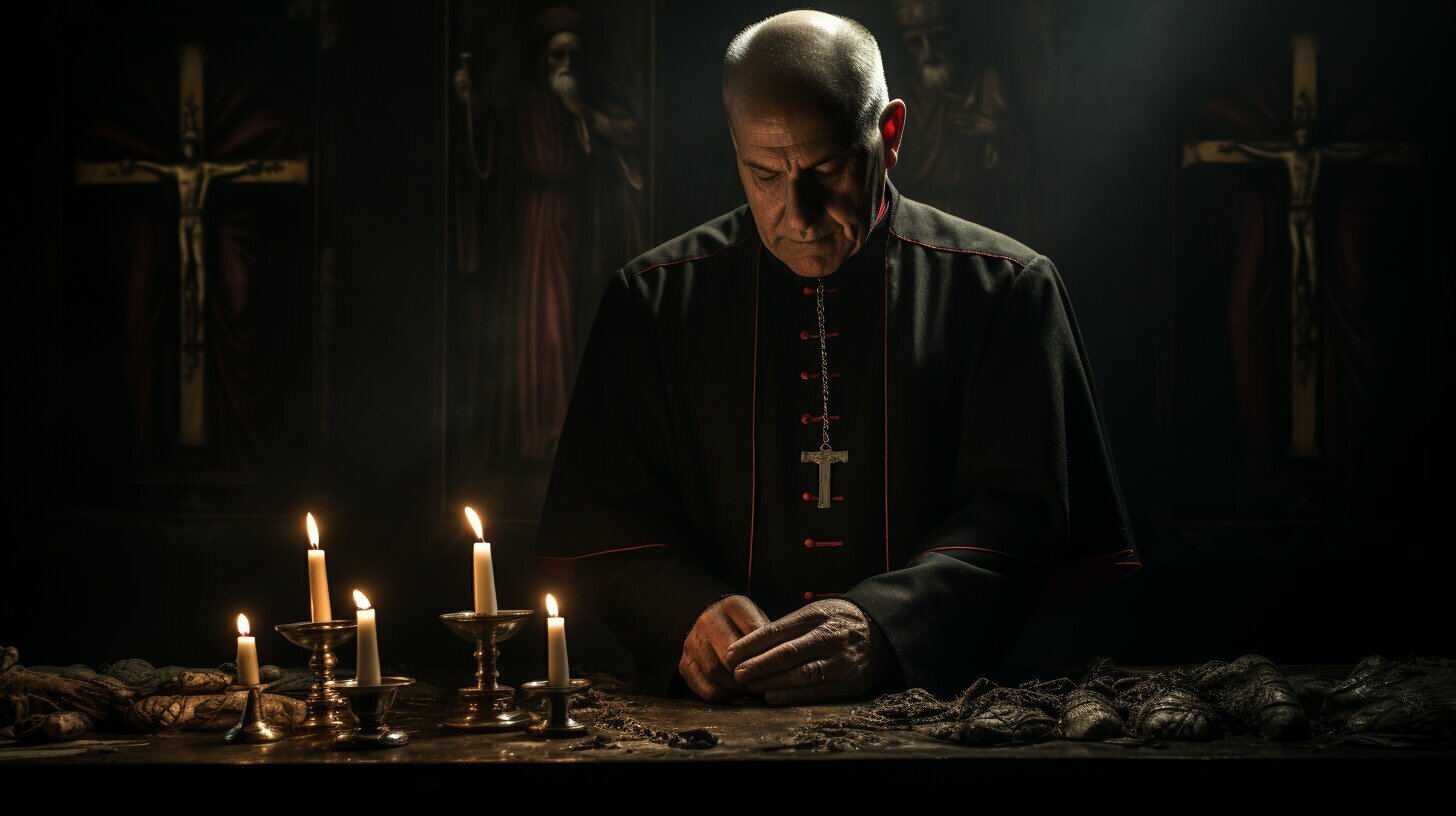Unraveling the Mystery: Why Do Priests Wear Black?
Welcome to the intriguing world of priestly attire, where the mystery of why priests wear black unfolds before our curious eyes. The black clothing worn by priests holds both historical and symbolic significance, providing a fascinating glimpse into their unique vocation. Let’s dive deeper into this enigma and uncover the reasons behind this distinctive religious attire.
Key Takeaways:
- The black attire worn by priests has a historical and symbolic significance
- The Roman cassock introduced during the 12th and 13th centuries became the distinctive everyday attire for priests
- Black represents simplicity, humility, and death, reminding priests of their need to imitate these virtues and die to self
- The black attire also symbolizes mourning and penitence, representing the sacrifices made by priests for their faith
- The white Roman collar worn by priests represents obedience and hope
- Priests may be granted dispensations to wear white in hotter climates
- The distinctiveness of black clothing sets priests apart and serves as a reminder of their mission to serve and point others towards heavenly things
The Historical Evolution of Priestly Attire
Embark on a journey through time as we unravel the captivating history behind the black robes donned by priests. In the early centuries of the Church, priests didn’t have a specific dress code and would wear everyday clothing. It was only during the 12th and 13th centuries that priests started wearing the Roman cassock as their distinctive everyday attire. This transition marked a significant shift in the way priests presented themselves to the world.
So, why did priests choose to wear black? The color black became associated with the cassock, likely due to the availability of black dye and its affordability. It soon became the standard color for priestly attire, symbolizing simplicity, humility, and death. By donning black robes, priests were reminded of their need to imitate these virtues and to die to self.
The black attire also carries a deeper meaning. It represents mourning and penitence, highlighting the sacrifices made by priests for their faith. It serves as a visual reminder of the dedication and commitment priests have towards their vocation, as they willingly embrace a life of selfless service.
While black remains the predominant color for priestly attire, there are exceptions. In hotter climates, priests are sometimes granted dispensations to wear white, which provides a cooler and more comfortable alternative. However, the distinctiveness of the black clothing sets priests apart and serves as a visible reminder of their mission to serve and point others towards heavenly things.
The Significance of Priestly Attire
| Color | Symbolism | ||||||||||||||||||||||||||
|---|---|---|---|---|---|---|---|---|---|---|---|---|---|---|---|---|---|---|---|---|---|---|---|---|---|---|---|
| Black | SimThe Symbolic Significance of Black GarmentsPrepare to unlock the hidden symbolism concealed within the folds of priests’ black vestments, as we dive into the depths of their religious meaning. The black attire worn by priests holds a profound representation of their faith and dedication to their vocation. Black, often associated with mystery and elegance, has been chosen as the color for priestly garments for centuries. It symbolizes simplicity, humility, and death, reminding priests of their need to imitate these virtues and die to self in order to fully embrace their calling. Just as darkness precedes the sunrise, the black attire serves as a constant reminder that priests must overcome their own darkness and strive to lead others towards the light of God’s love and forgiveness. Mourning and penitence are also embodied in the black clothing of priests. The somber hue reflects the sacrifices made by these spiritual leaders for their faith. It serves as a visual reminder of the heavy burdens they carry on behalf of their congregations and the devotion required to fulfill their role as spiritual guides.
Furthermore, the white Roman collar worn by priests serves as an additional symbol within their black attire. It represents obedience and hope, signifying the priest’s commitment to following the teachings of the Church and their mission to bring hope to the lives of those they serve. While black remains the standard color for priestly attire, there are exceptions made for priests serving in hotter climates, where they may be granted dispensations to wear white, which reflects heat more effectively. However, the distinctiveness of the black clothing serves as a visual reminder of the sacredness of the priesthood and sets priests apart, reminding them of their mission to serve as spiritual guides and point others towards heavenly things. In SummaryThe black garments worn by priests hold profound symbolic meaning. They represent simplicity, humility, and death, reminding priests to embrace these virtues and imitate Christ. The black attire also signifies mourning and penitence, reflecting the sacrifices made by priests for their faith. The white Roman collar worn by priests symbolizes obedience and hope. While black remains the standard color for priestly attire, exceptions may be made for priests in hotter climates who may wear white instead. The distinctiveness of the black clothing sets priests apart and serves as a constant reminder of their mission to serve and lead others towards heavenly things. The Distinctiveness and Versatility of Priestly AttireDiscover the multifaceted nature of priests’ black clothing, which not only sets them apart but also serves as a powerful symbol and a testament to their mission. The black attire worn by priests holds deep religious symbolism and cultural significance, making it an essential part of their identity. The reasons why priests wear black are rooted in history and tradition. During the 12th and 13th centuries, priests began wearing the Roman cassock as their distinctive everyday attire. The color black became associated with the cassock, possibly due to the availability of black dye and its affordability. It has since become the standard color for priestly garments, representing simplicity, humility, and death. Black reminds priests of the virtues they strive to embrace and calls them to die to self, focusing on their sacred mission. Furthermore, the black clothing worn by priests symbolizes mourning and penitence. It represents the sacrifices that priests make for their faith, acknowledging the challenges and difficulties they encounter along their spiritual journey. The black attire is a constant reminder of the selflessness required in their service to others and their commitment to God. The versatility of the black attire is also worth noting. While black is the customary color, priests in hotter climates are sometimes granted dispensations to wear white, allowing them to adapt their clothing to the local climate. This demonstrates the Church’s recognition of the practicality and comfort required for priests to carry out their duties effectively.
Embracing Tradition and Looking AheadAs we conclude our exploration into the mysteries of priests’ black attire, let us reflect on the timeless traditions upheld by these dedicated individuals and the hope they inspire. The black clothing worn by priests carries both historical and symbolic significance, serving as a visual reminder of their sacred calling. Throughout history, priests have donned black robes as a distinctive everyday attire, representing their dedication to serving God and their community. The color black became associated with the Roman cassock, likely due to the availability and affordability of black dye during the 12th and 13th centuries. This tradition has endured, with priests continuing to wear black as a symbol of simplicity, humility, and death, virtues they strive to embody in their daily lives. Black attire also carries a symbolism of mourning and penitence, signifying the sacrifices priests make for their faith. It serves as a constant reminder of their mission to bring comfort and hope to those in need, even in the midst of their own personal challenges. The white Roman collar worn by priests further emphasizes their commitment to obedience and the hope they bring to their congregations. While black remains the standard color for priestly attire, allowances are sometimes made for priests in hotter climates to wear white. This recognition of the practicalities of different environments does not diminish the distinctive nature of the black clothing, but rather highlights the adaptability and flexibility of the priesthood. It is a testament to the enduring traditions upheld by priests, as they continue to serve as beacons of faith and inspiration in an ever-changing world.
As we conclude our exploration into the mysteries of priests’ black attire, let us appreciate the rich symbolism and the unwavering commitment it represents. These dedicated individuals, through their choice of clothing, embody the values of their faith and inspire hope in the hearts of their communities. ConclusionThrough this fascinating journey, we have unraveled the enigma behind why priests wear black, uncovering a tapestry woven with history, symbolism, and unwavering devotion. The black attire worn by priests holds a significant place in the religious and cultural landscape. In the early centuries of the Church, priests donned ordinary clothing, reserving their priestly vestments for Mass. However, as time passed, the Roman cassock emerged as the distinctive everyday attire for priests. The color black became associated with this attire, likely due to the availability and affordability of black dye. Black carries a deep symbolic meaning for priests. It represents simplicity and humility, reminding priests of the virtues they strive to embody. It also signifies death, calling priests to die to themselves and embrace a life of service. Additionally, black is associated with mourning and penitence, symbolizing the sacrifices made by priests for their faith. While black remains the standard color for priestly attire, there are instances where priests in hotter climates may be granted dispensations to wear white. Nevertheless, the distinctiveness of the black clothing worn by priests sets them apart and serves as a constant reminder of their sacred mission to serve and point others towards heavenly things. FAQWhy do priests wear black?Priests wear black as a symbol of simplicity, humility, and death, reminding them of the virtues they strive to embrace. It also signifies mourning, penitence, and the sacrifices made for their faith. What is the historical significance of priests’ black attire?In the 12th and 13th centuries, priests started wearing the Roman cassock as their distinctive everyday attire, and black became associated with it. This historical evolution of priestly attire plays a role in the black clothing tradition. Can priests wear white instead of black?While black remains the standard color for priestly attire, priests in hotter climates may be granted dispensations to wear white. This allows for practicality and comfort without compromising the distinctiveness of their clothing. What does the white Roman collar worn by priests symbolize?The white Roman collar represents obedience and hope, serving as a visual reminder of the virtues priests aim to embody in their service to others. Why is it important for priests to wear distinctive clothing?The black attire sets priests apart and serves as a constant reminder of their mission to serve others and point them towards heavenly things. It also carries cultural and religious significance in representing their role and dedication to their faith. |






